
They were flailing around again.
The Cubs lost a then-franchise record 93 games in 1949. The .396 winning percentage is roughly equivalent to a 98-loss season in a 162-game schedule.
Did the Cubs do anything to improve this in 1950? No, no, they did not. They hired Wid Matthews, who had been highly thought of as a Branch Rickey colleague with the Cardinals and Dodgers, as “director of player personnel.” That wasn’t a general manager’s title, but Matthews became the de facto GM, a position he’d hold through 1956.
I’m including one transaction that wasn’t a player-for-player trade here because I think it’s emblematic of what the Cubs would do for most of the 1950s — and even into the 1960s.
February 10: Acquired Johnny Vander Meer from the Reds for cash considerations
Vander Meer, of course, had blazed onto the national scene in 1938 when he threw back-to-back no-hitters. And, truth be told, he was a very good pitcher for the Reds from 1938-43, a four-time All-Star who got downballot MVP votes twice. He led the NL in strikeouts three straight years from 1941-43, but with declining K numbers each year.
Then, like many in that era, he went off to service in World War II and came back not as good as he once was. He still pitched decently from 1946-48, including a 5.5 bWAR year in ‘48, not as well in ‘49, then the Reds figured he was done.
Not the Cubs! Vander Meer was 35 before the 1950 season began and they used him largely in relief — only six starts in 32 appearances, and he actually pitched pretty well as a reliever. Not well enough that they’d keep him around — he was released after the season ended.
It seemed a move to bring in a fading star and maybe he’d sell some tickets. Did that work? Probably not. The non-contending Cubs won three more games than they had in 1949 and sold 22,805 more tickets, an increase of 1.9 percent.
It was just pointless.
June 7: Acquired Ron Northey from the Cincinnati Reds for Bob Scheffing
Scheffing had been a Cubs catcher since 1941 (save three years out for military service during the war), and caught over 100 games for them in 1947 and 1948. He was done playing after 1951. After a coaching stint with the St. Louis Browns, he was hired to manage the Cubs top minor league team in Los Angeles, where he won a PCL pennant in 1956. That got him promoted to the Cubs as manager for 1958 and 1959. Both of those were very good seasons, but inexplicably he was fired after ‘59. Scheffing went on to manage the Tigers and became GM of the Mets in the 1970s.
The Cubs should have kept him.
Northey had been a good pre-war player, too, for the Phillies, getting downballot MVP votes in 1943 and 1944. He hit reasonably well for them the rest of 1950 (.281/.339/.465 in 53 games), but missed the entire 1951 season with knee injuries, eventually returning for just one game in 1952 before being sent to the Tigers.
They should have just kept Scheffing.
October 10: Acquired Chuck Connors and Dee Fondy from the Dodgers for Hank Edwards and cash
This was actually a decent trade for the Cubs. Fondy became the Cubs’ regular first baseman for most of the next six seasons, and in 1952 batted .309/.358/.477 with 18 home runs. Between Fondy and Hank Sauer, they had a couple of very good offensive players. Now if they only hadn’t traded away Andy Pafko the year before…
Chuck Connors, generally referred to in newspapers at the time of the trade by his given name, Kevin, had been blocked in the Dodgers minor league system, getting only one at-bat with them, in 1949. He had also played pro basketball for a couple years with the Boston Celtics in the late 1940s.
With the Cubs he hit .239/.282/.303 in 66 games after spending much of the first half of the year with the team’s top farm club in Los Angeles, taking over for Fondy, who hadn’t played well early in ‘51.
But after the season he was returned to Los Angeles, and that’s where he caught his big break. From Connors’ SABR biography:
In September 1951, Connors received a phone call that changed his life. Bill Grady, the casting director for Metro-Goldwyn-Mayer, was a passionate fan of the Los Angeles Angels and asked Connors to test for a small role in the movie Pat and Mike, a film starring Spencer Tracy and Katharine Hepburn. Connors got the five-minute part as the police captain and was paid $500 for just a few hours of work. Connors had found his post-baseball career. “I said right then, this is my racket,” Connors remembered. “Playing with Tracy and Hepburn, I was in the big leagues much faster than I arrived there in baseball.”
Connors played with the Angels in 1952, but then left baseball for an acting career that included the starring role in the TV series The Rifleman, as well as appearances in several movies and the TV miniseries Roots. He wasn’t a great ballplayer, but he did get himself a star on the Hollywood Walk of Fame.
Oh, yes, Hank Edwards. He played in only 35 games for the Dodgers before they shipped him to the Reds. He wrapped his baseball career in 1953 with the St. Louis Browns.
For Fondy’s several good years with the Cubs, this was a good trade.
That’s it for 1950 Cubs trades. The Fondy deal was good, but not good enough to keep this year from a D+ grade.
